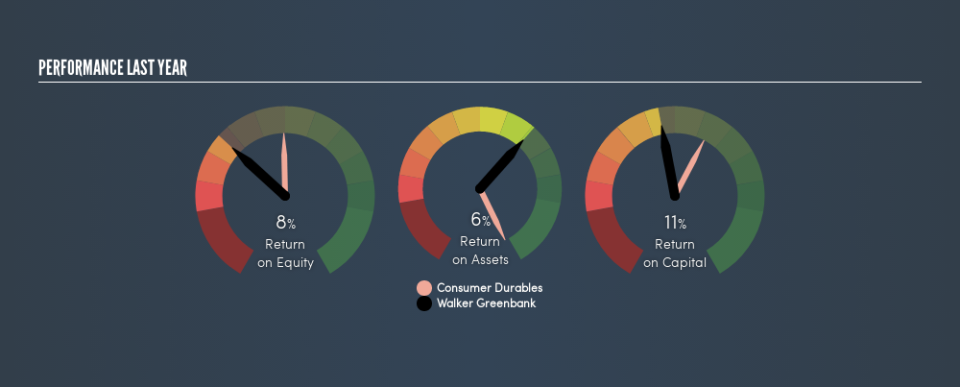Examining Walker Greenbank PLC’s (LON:WGB) Weak Return On Capital Employed

Want to participate in a short research study? Help shape the future of investing tools and you could win a $250 gift card!
Today we'll evaluate Walker Greenbank PLC (LON:WGB) to determine whether it could have potential as an investment idea. Specifically, we're going to calculate its Return On Capital Employed (ROCE), in the hopes of getting some insight into the business.
First up, we'll look at what ROCE is and how we calculate it. Next, we'll compare it to others in its industry. And finally, we'll look at how its current liabilities are impacting its ROCE.
Return On Capital Employed (ROCE): What is it?
ROCE measures the amount of pre-tax profits a company can generate from the capital employed in its business. Generally speaking a higher ROCE is better. Ultimately, it is a useful but imperfect metric. Author Edwin Whiting says to be careful when comparing the ROCE of different businesses, since 'No two businesses are exactly alike.'
How Do You Calculate Return On Capital Employed?
The formula for calculating the return on capital employed is:
Return on Capital Employed = Earnings Before Interest and Tax (EBIT) ÷ (Total Assets - Current Liabilities)
Or for Walker Greenbank:
0.11 = UK£7.7m ÷ (UK£95m - UK£24m) (Based on the trailing twelve months to January 2019.)
Therefore, Walker Greenbank has an ROCE of 11%.
See our latest analysis for Walker Greenbank
Is Walker Greenbank's ROCE Good?
When making comparisons between similar businesses, investors may find ROCE useful. We can see Walker Greenbank's ROCE is meaningfully below the Consumer Durables industry average of 15%. This performance is not ideal, as it suggests the company may not be deploying its capital as effectively as some competitors. Regardless of where Walker Greenbank sits next to its industry, its ROCE in absolute terms appears satisfactory, and this company could be worth a closer look.
Walker Greenbank's current ROCE of 11% is lower than its ROCE in the past, which was 15%, 3 years ago. Therefore we wonder if the company is facing new headwinds. You can see in the image below how Walker Greenbank's ROCE compares to its industry. Click to see more on past growth.
When considering ROCE, bear in mind that it reflects the past and does not necessarily predict the future. Companies in cyclical industries can be difficult to understand using ROCE, as returns typically look high during boom times, and low during busts. ROCE is only a point-in-time measure. Future performance is what matters, and you can see analyst predictions in our free report on analyst forecasts for the company.
How Walker Greenbank's Current Liabilities Impact Its ROCE
Current liabilities are short term bills and invoices that need to be paid in 12 months or less. Due to the way the ROCE equation works, having large bills due in the near term can make it look as though a company has less capital employed, and thus a higher ROCE than usual. To counteract this, we check if a company has high current liabilities, relative to its total assets.
Walker Greenbank has total assets of UK£95m and current liabilities of UK£24m. Therefore its current liabilities are equivalent to approximately 25% of its total assets. Current liabilities are minimal, limiting the impact on ROCE.
Our Take On Walker Greenbank's ROCE
Overall, Walker Greenbank has a decent ROCE and could be worthy of further research. Walker Greenbank looks strong on this analysis, but there are plenty of other companies that could be a good opportunity . Here is a free list of companies growing earnings rapidly.
If you are like me, then you will not want to miss this free list of growing companies that insiders are buying.
We aim to bring you long-term focused research analysis driven by fundamental data. Note that our analysis may not factor in the latest price-sensitive company announcements or qualitative material.
If you spot an error that warrants correction, please contact the editor at editorial-team@simplywallst.com. This article by Simply Wall St is general in nature. It does not constitute a recommendation to buy or sell any stock, and does not take account of your objectives, or your financial situation. Simply Wall St has no position in the stocks mentioned. Thank you for reading.

